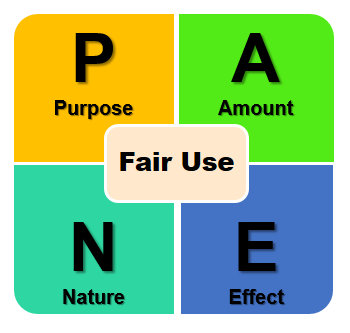By Kristy Padron, MLIS
Scholarly Communication Services Coordinator
Disclaimer: The FAU Libraries and its faculty, staff, and administration are not attorneys and cannot interpret the law. This information is provided for educational purposes only and does not substitute for advice from legal counsel.
The Fair Use Doctrine, also known as fair use, is a commonly used and frequently confused part of copyright law. With its 175 words, it is in Section 107 of the U.S. Copyright Act of 1976; however, it is not a strict guideline. Fair use provides a framework that allows new applications, uses, or creations that are based on works protected by copyright. It is used a lot for library and educational settings, and also in creative and scholarly activities.
Despite Section 107’s brevity and apparent flexibility of use, it is subject to misuse and misunderstanding. Here are some frequent ones:
- “If I found a PDF of a book I found on the Internet and embed it in my Canvas course page, it’s fair use because it’s for educational purposes.”
- “If I use content from a work protected by copyright in my assignment (or manuscript) and cite the source, I’m not infringing on its copyright.”
- “If I scan only 10% of a textbook and give it to my class so they don’t have to buy it, it’s fair use.”

Each scenario re-uses or builds on work protected by copyright. To be sure fair use can apply, a fair use analysis is essential because it will help discern attributes of the work being used and the conditions of its use. Section 107 provides 4 factors to consider:
- Purpose of Use: Is the use transformative? Why is the work being used, and for what reason? Does its copying or use add a new meaning, character, message, or function of the work?
- Amount and Proportion of Work Used: How much of an original work is being used in proportion to the original work, or is it a significant part of the work?
- Nature of Work: Is the copyrighted work based on fact, or is it a creative work? Is the work published or unpublished? Is the purpose of the copyrighted work to inform or entertain?
- Effect of Reuse on its Market or Demand: Does copying or reusing the work make it less valuable or affect the demand for it?
A fair use analysis is not numerically determined (“3 of the 4 factors apply, so it’s fair use!”). Instead, it is determined by balancing the 4 factors and then is individually considered by one’s own tolerance for risk.
Fair use gives considerable rights to use information for instructional and scholarly/ creative purposes, and you will be more comfortable with making these determinations the more you do them. Please see the following LibGuides to do a fair use analysis, or to learn more about fair use.
More Information
- Title 17 § 107, Limitations on exclusive rights: Fair use (U.S. Copyright Office): https://www.copyright.gov/title17/92chap1.html#107
- SCS Copyright for Teaching and Instruction: https://libguides.fau.edu/scs-copyright-for-teaching
- SCS Copyright for Teaching and Instruction – Fair Use: https://libguides.fau.edu/scs-copyright-for-teaching/fair-use
 FLORIDA ATLANTIC UNIVERSITY
FLORIDA ATLANTIC UNIVERSITY
